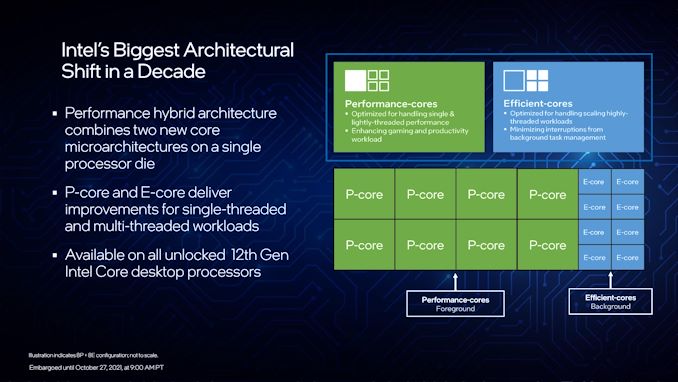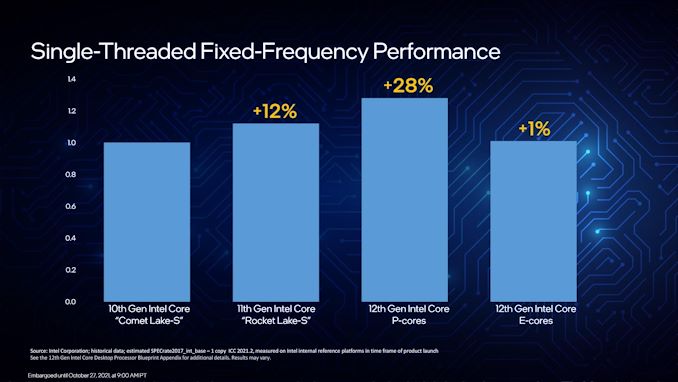Intel 12th Gen Core Alder Lake for Desktops: Top SKUs Only, Coming November 4th
by Dr. Ian Cutress on October 27, 2021 12:00 PM EST- Posted in
- CPUs
- Intel
- DDR4
- DDR5
- PCIe 5.0
- Alder Lake
- Intel 7
- 12th Gen Core
- Z690
A Hybrid/Heterogeneous Design
Developing a processor with two different types of core is not a new concept – there are billions of smartphones that have exactly that inside them, running Android or iOS, as well as IoT and embedded systems. We’ve also seen it on Windows, cropping up on Qualcomm’s Windows on Snapdragon mobile notebooks, as well as Intel’s previous Lakefield design. Lakefield was the first x86 hybrid design in that context, and Alder Lake is the more mass-market realization of that plan.
A processor with two different types of core disrupts the typical view of how we might assume a computer works. At the basic level, it has been taught that a modern machine is consistent – every CPU has the same performance, processes the same data at the same rate, has the same latency to memory, the same latency to each other, and everything is equal. This is a straightforward homogenous design that’s very easy to write software for.
Once we start considering that not every core has the same latency to memory, moving up to a situation where there are different aspects of a chip that do different things at different speeds and efficiencies, now we move into a heterogeneous design scenario. In this instance, it becomes more complex to understand what resources are available, and how to use them in the best light. Obviously, it makes sense to make it all transparent to the user.
With Intel’s Alder Lake, we have two types of cores: high performance/P-cores, built on the Golden Cove microarchitecture, and high efficiency/E-cores, built on the Gracemont microarchitecture. Each of these cores are designed for different optimization points – P-cores have a super-wide performance window and go for peak performance, while E-cores focus on saving power at half the frequency, or lower, where the P-core might be inefficient.
This means that if there is a background task waiting on data, or something that isn’t latency-sensitive, it can work on the E-cores in the background and save power. When a user needs speed and power, the system can load up the P-cores with work so it can finish the fastest. Alternatively, if a workload is more throughput sensitive than latency-sensitive, it can be split across both P-cores and E-cores for peak throughput.
For performance, Intel lists a single P-core as ~19% better than a core in Rocket Lake 11th Gen, while a single E-core can offer better performance than a Comet Lake 10th Gen core. Efficiency is similarly aimed to be competitive, with Intel saying a Core i9-12900K with all 16C/24T running at a fixed 65 W will equal its previous generation Core i9-11900K 8C/16T flagship at 250 W. A lot of that will be that having more cores at a lower frequency is more efficient than a few cores at peak frequency (as we see in GPUs), however an effective 4x performance per watt improvement requires deeper investigation in our review.
As a result, the P-cores and E-cores look very different. A deeper explanation can be found in our Alder Lake microarchitecture deep dive, but the E-cores end up being much smaller, such that four of them are roughly in the same area as a single P-core. This creates an interesting dynamic, as Intel highlighted back at its Architecture Day: A single P-core provides the best latency-sensitive performance, but a group of E-cores would beat a P-core in performance per watt, arguably at the same performance level.
However, one big question in all of this is how these workloads end up on the right cores in the first place? Enter Thread Director (more on the next page).
A Word on L1, L2, and L3 Cache
Users with an astute eye will notice that Intel’s diagrams relating to core counts and cache amounts are representations, and some of the numbers on a deeper inspection need some explanation.
For the cores, the processor design is physically split into 10 segments.
A segment contains either a P-core or a set of four E-cores, due to their relative size and functionality. Each P-core has 1.25 MiB of private L2 cache, which a group of four E-cores has 2 MiB of shared L2 cache.
This is backed by a large shared L3 cache, totaling 30 MiB. Intel’s diagram shows that there are 10 LLC segments which should mean 3.0 MiB each, right? However, moving from Core i9 to Core i7, we only lose one segment (one group of four E-cores), so how come 5.0 MiB is lost from the total L3? Looking at the processor tables makes less sense.
Please note that the following is conjecture; we're awaiting confirmation from Intel that this is indeed the case.
It’s because there are more than 10 LLC slices – there’s actually 12 of them, and they’re each 2.5 MiB. It’s likely that either each group of E-cores has two slices each, or there are extra ring stops for more cache.
Each of the P-cores has a 2.5 MiB slice of L3 cache, with eight cores making 20 MiB of the total. This leaves 10 MiB between two groups of four E-cores, suggesting that either each group has 5.0 MiB of L3 cache split into two 2.5 MiB slices, or there are two extra LLC slices on Intel’s interconnect.
| Alder Lake Cache | |||||||
| AnandTech | Cores P+E/T |
L2 Cache |
L3 Cache |
IGP | Base W |
Turbo W |
Price $1ku |
| i9-12900K | 8+8/24 | 8x1.25 2x2.00 |
30 | 770 | 125 | 241 | $589 |
| i9-12900KF | 8+8/24 | 8x1.25 2x2.00 |
30 | - | 125 | 241 | $564 |
| i7-12700K | 8+4/20 | 8x1.25 1x2.00 |
25 | 770 | 125 | 190 | $409 |
| i7-12700KF | 8+4/20 | 8x1.25 1x2.00 |
25 | - | 125 | 190 | $384 |
| i5-12600K | 6+4/20 | 6x1.25 1x2.00 |
20 | 770 | 125 | 150 | $289 |
| i5-12600KF | 6+4/20 | 6.125 1x200 |
20 | - | 125 | 150 | $264 |
This is important because moving from Core i9 to Core i7, we lose 4xE-cores, but also lose 5.0 MiB of L3 cache, making 25 MiB as listed in the table. Then from Core i7 to Core i5, two P-cores are lost, totaling another 5.0 MiB of L3 cache, going down to 20 MiB. So while Intel’s diagram shows 10 distinct core/LLC segments, there are actually 12. I suspect that if both sets of E-cores are disabled, so we end up with a processor with eight P-cores, 20 MiB of L3 cache will be shown.













395 Comments
View All Comments
Hifihedgehog - Wednesday, October 27, 2021 - link
Well, that rules you out, Pip... err... lmcd.Spunjji - Thursday, October 28, 2021 - link
Evidently not, given the presence of ghastly fanbots like you.nicamarvin - Wednesday, October 27, 2021 - link
These gaming numbers are with crippled Win11 for AMD, so right there the 15% is out of the windows and more like 5%, Amd 3D Cache will land when a mature W11 is out and they will take back the gaming lead by a good marginWrs - Wednesday, October 27, 2021 - link
It is still an assumption that L3/L4 cache quantity would help that much for gaming. Remember increasing the cache size also increases latency. Ever notice the 5800x beating the 5950x in games? The 5800x has 32mb L3 on one CCD, the 5950x 64mb L3 split across two CCDs. There's good reason it's taking AMD a whole year to release 3d-cache on the same cores. It's a heterogeneous implementation and takes a lot of work and trial & error to minimize latencies.nicamarvin - Wednesday, October 27, 2021 - link
AMD said that 3D Cache would not increase latenciesGigaplex - Thursday, October 28, 2021 - link
"Remember increasing the cache size also increases latency."Not always. Going from L2 to L3 increases latency, but doubling the size of L3 doesn't increase latency.
"The 5800x has 32mb L3 on one CCD, the 5950x 64mb L3 split across two CCDs."
That's a NUMA type issue, not a cache size issue.
Spunjji - Thursday, October 28, 2021 - link
"It is still an assumption that L3/L4 cache quantity would help that much for gaming"Not really. L4 on Broadwell helped a bunch, and this is tripling the L3 cache with little-to-no latency penalty. What remains to be seen is whether or not they can retain high clock speeds, and what the cost is.
nicamarvin - Wednesday, October 27, 2021 - link
"Intel shows showing the 12900K being anywhere from slightly slower than the Ryzen 9 5950X, to being 30 percent faster. However, Intel does admit that these benchmarks were captured on Windows 11 before the performance patch for AMD CPUs was available, so the results aren’t as meaningful as they would have been had they tested the 5950X in its best performing mode, such as using Windows 10 or waiting for the patch to be available"WaltC - Wednesday, October 27, 2021 - link
I am very underwhelmed so far...but time will tell. I am, however, delighted to see Intel put out a new architecture at long last...;) Something tells me that seeing the most game performance possible will require *a lot* of optimization--so hopefully Intel will have good compilers ready to go! The article says that Z690 is a PCIe 4.0 chipset--is that right? Does that mean the Intel hasn't yet produced a PCIe5.0-supporting chipset? Didn't quite understand that one.Going to be interesting to see how this shapes out...;)
Spunjji - Thursday, October 28, 2021 - link
Alder Lake has PCIe 5.0 lanes from the CPU - 16 of them - but there are no PCIe 5.0 lanes from the chipset, and the chipset connects to the CPU over a PCIe 4.0 equivalent link.